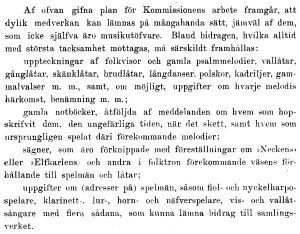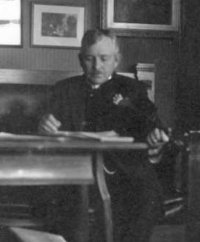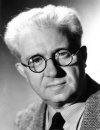The Activities of Folkmusikkommissionen
Folkmusikkommissionen (The Folk Music Commission) existed formally from 1908 to 1976, but most of its activity was during the periods 1908-1911 and 1922-1940. The name Folkmusikkommissionen leads one's thoughts to an official committee appointed by the parliament, and many who were active in the area of traditional music also perceived it as such. Despite its name, the commission was in fact established by about sixty collectors and researchers in folk culture at a meeting at The Nordic Museum in Stockholm in the summer of 1908.
1908–1921

From Folkmusikkommissionen's appeal 1909
The initiator of Folkmusikkommissionen, and initially its leader, was the lawyer and traditional music collector Nils Andersson (1864-1921), who was more and more becoming the leading traditional music collector in Sweden at the beginning of the 20th century. Among the eight members of Folkmusikkommissionen were Bernhard Salin, director of The Nordic Museum, the violinist Lars Johan Zetterquist, the painter Anders Zorn (who also initiated the first Swedish traditional music competition in Gesunda in 1906) and prince Eugen, who was made honorary chairman. From the beginning, Folkmusikkommissionen had a strong support among music and museum institutions, researchers and royalty, which emphasized its national, nearly official status.
The first task of Folkmusikkommissionen was to send out an appeal for old tunes and songs in 1909, where they also asked for information about the music, the instruments and musicians. The intent was already from the beginning to gather the material, select from it, edit and publish so that it could be brought back to the musicians, thereby also making it useful to researchers and composers.

The first secretary of Folkmusikkommissionen, Nils Andersson tries out fingerings on the fiddle while making a clean copy of his transcriptions. Otherwise the flute was Nils Andersson's main instrument, which he used when transcribing, but towards the end of his life he also started playing the fiddle. In a letter to Hjalmar Wijk from 1919, Nils Andersson writes that he is practising his "previous slight proficiency on fiddle. I still use it as a tool, trying out every fingering and bowing. With the fiddle (flute) and my abnormally strong memory for music and details I see every musician and his playing before and can see whether (and that) my transcriptions are correct, as well as clearing up the dark patches that may remain here and there.
(Photo from Svenskt visarkiv)
Thanks to this appeal about 40 collections (volumes I:E II:1-7, "Upprop") were sent to The Nordic Museum, who initially had the responsibility for Folkmusikkommissionen. The collections also grew through Nils Andersson's own collecting and through the work of other collectors who were in direct contact with him.
Apart from musical contributions they also requested economical ones. This was initially solved when Nils Andersson in 1910 joined in the application by the folklorists Tobias Norlind and Carl Wilhelm von Sydow for government grants to collect folklore, backed by the university of Lund. The parliament voted for this and they got a grant from 1913 to 1920. Apart from this, from the middle of the 1910s, Nils Andersson got economical support from the shopkeeper and member of parliament Hjalmar Wijk, who for instance paid for the publishing of the first two parts of Svenska låtar. The original Folkmusikkommissionen did not have any meetings after 1911, since the problem of economic support seemed to be solved and so much material was available that they thought that only editing of the collections remained to be done. However, this was not the case, it turned out.
1922–1945
Folkmusikkommissionen resumed its work again in 1922, after Nils Andersson's sudden death in 1921, and the continued publishing of Svenska låtar needed leadership. The commission got some new members, among them Tobias Norlind (who had been appointed director of the Stockholm Music Museum some years earlier) and Hjalmar Wijk. With government support, contributions from various funds and private donations, the commission could publish yearly parts of Svenska låtar (1922–1940) – all together 24 issues – and then Folkliga svenska koralmelodier från Gammalsvenskby och Estland (1945).
The task to continue the collection and editing of the collections of Folkmusikkommissionen was entrusted to the musician Olof Andersson (1884–1964), who since 1909 had worked with Nils Andersson and eventually appeared to become his closest collaborator. However, Olof Andersson was never a member of the commission. During the 1920s and 1930s Olof Andersson made yearly collection tours to various parts of the country – in 1931 he also went to the Swedish-speaking parts of Estonia – to verify and add to the previously collected material. Apart from this he also kept up an extensive correspondence about traditional music (today in the collection "Folkmusik, Brev" at Svenskt visarkiv).
From 1930 onwards, Tobias Norlind had more actively started creating a traditional music archive at the Stockholm Music Museum, and in 1936 Folkmusikkommissionen's collections were deposited there, and Olof Andersson was employed to work with the material. The museum was founded in 1899 and already had a collection of older handwritten music books with dance repertoire (spelmansböcker). With the addition of the commission's material the Stockholm Music Museum (today The Swedish Museum of performing Arts) thus had the largest archive in Sweden of Swedish traditional music.
1946–1976

Olof Andersson was the one who worked the longest time for Folkmusikkommissionen, from the 1910s until the 1960s. From the 1920s Olof Andersson carried out most of the practical work of collection, selection and editing of the material for publishing in Svenska låtar. He also performed regularly on the radio as a traditional musician, and as an authority in Swedish traditional music he judged several fiddlers' competitions and was part of the jury for the Zorn award.
(Photo from Svenskt visarkiv)
After the publication of the material, Olof Andersson spent most of his work until his retirement in 1961 making indexes of the collections, among them an index of melody versions in Folkmusikkommissionen's material and other Swedish collections. The melody index consists of cross references between similar melodies in the collection starting from their first occurrence in Svenska låtar – because of this many melodies have their codes from the Dalarna parts of Svenska låtar, since these were published first. In many of the transcriptions and dance music books Olof Andersson has noted the melody type, e.g. "Sv.L. Häls. 560", and copies of these melodies were also added to the melody index which was created later.
The last notes of any activity connected with Folkmusikkommissionen are from 1967, but it was not formally dissolved until 1976, when the collections were moved to the former Stockholm Music Museum. That same year Folkmusikkommissionen's archive was put in order and around the middle of the 1990s Jan Hellberg made a more detailed catalogue of the contents of each volume of original transcriptions (series IIb). The responsibility for the traditional music collections of the former Stockholm Music Museum (today The Swedish Performing Arts Museum) has been taken over by Svenskt visarkiv [The Centre for Swedish Folk Music and Jazz Research] since 2003, and this is the today the agency to contact for questions about these collections. (Questions about musical instruments should be addressed to The Swedish Performing Arts Museum.)
(This presentation is an abbreviated and updated version of a longer article about Folkmusikkommissionen, published in Dokumenterat 37, 2006). Download Dokumenterat 37.)
This website uses cookies.
Read about how the Swedish Performing Arts Agency processes personal data.